ETC Electrifies the Wonders of ‘Illinoise’ on Broadway
July 15, 2024
Broadway’s offbeat sweetheart is Illinoise, an awe-inspiring dance musical derived from the 2006 Sufjan Stevens album of the same name. The four-time Tony nominated show, created by choreographer Justin Peck (who won Illinoise the Tony for Best Choreography), is lit by Peck’s longtime collaborator Brandon Stirling Baker. Illinoise runs on an Eos Ti, programmed by Jeff Englander. Stirling Baker’s joyous lighting design earned him a Tony nomination for his Broadway debut.
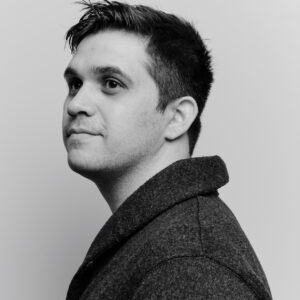
It’s a production over a decade in the making. Peck and Stirling Baker’s long-running artistic partnership began with Year of the Rabbit at the New York City Ballet, a performance set to the music of Sufjan Stevens’ 2001 album Enjoy Your Rabbit. The pair quickly bonded over a shared love of Stevens’ music, the Illinois album in particular. “We both grew up listening to this album,” says Brandon Stirling Baker. “Justin and I have been geeking out over Illinois as a project for 14 years now.”
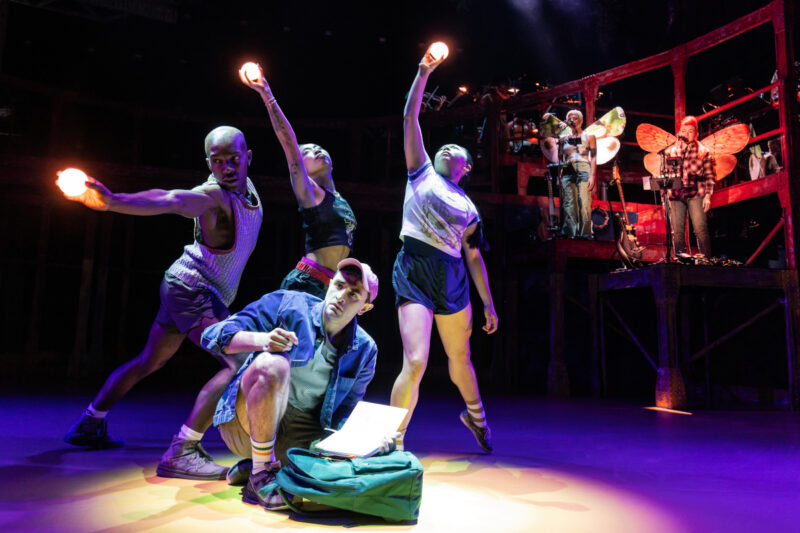
After years of incubation, Illinoise first took physical shape at Bard Summerscape in 2022. “It was a very abstract piece,” says Stirling Baker. “It was extremely weird, but we loved it. We were very into creating a so-called musical without following the traditional jukebox structure.” From there, the show landed at the Chicago Shakespeare Theatre. “I think the show really found itself in Chicago,” programmer Jeff Englander says—fitting for a production whose best-known number is named after the city. After a month in Chicago, Illinoise plowed ahead to the Park Avenue Armory in New York City. “The Armory is one of the coolest spaces in America,” says Stirling Baker. “It’s 400 feet deep, 80 feet tall — It has the feeling of a football stadium, but for the arts, you know? It has always been a bucket list venue for Justin and me because you can really do anything in there.”
Moving an ever-evolving musical between wildly different venues on a tight schedule could have been a programming nightmare without the right tools. Luckily, Englander’s extensive use of Augment3d made transfers a breeze: “Thank God for 3D visualizing! Augment3d was extremely important to how I transferred the show from one venue to the next. The 3D makes the focus nearly perfect, so all we had to do was mess with the beam parameters a bit to make things look good.”
After the news arrived that Illinoise was heading to Broadway, opening night came only three weeks later. “Justin and I come from the world of ballet, where we’ll do tech in the morning, dress rehearsal in the afternoon, and open that night, which is very normal for us. This was like doing a Broadway musical on a dance schedule,” Stirling Baker jokes.
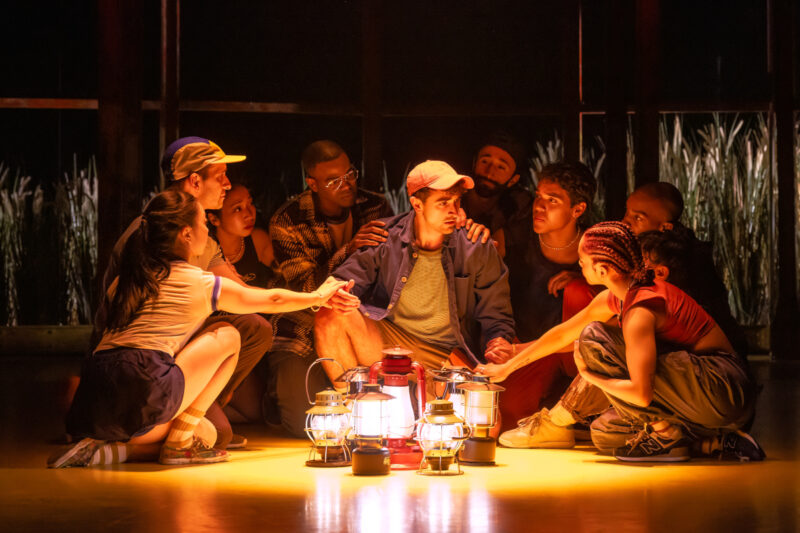
Englander was in the middle of another job when the transfer was to take place, so he entrusted his show file to David Arch to transfer to the St. James Theatre. “I was the programmer on the first Broadway show that Brandon worked on as an assistant, and now this is his first Broadway show as a designer, so it was very full circle,” says Arch. “Jeff did a great job, so it was really just a matter of me refining it and working in the new equipment.”
When questions arose about upgrading certain equipment in the transfer, the team opted to keep things simple. “We come from very humble beginnings and the show only got smaller and nimbler as we went along,” says Stirling Baker. “We’re just a show with music, dance and light, and I’m very proud that that was enough. Our very first iteration of the show at Bard had a bigger light plot than the Broadway version.”
From Bard to Broadway, Eos Ti remained the console of choice. “I love that the Ti has a row of programmable hard keys that are horizontal. Because as it turns out, my hands happen to be horizontal as well,” says Englander. Arch puts it simply: “Sitting at the Ti feels like coming home.”
“What’s really exciting is that even with so much electric energy and light, the cueing is very simple. For me, it was super important that the choreography dictated how the lighting cues would happen. For every song in the show, a lot of the cues and lighting ideas in general are inspired by the choreography,” says Stirling Baker.
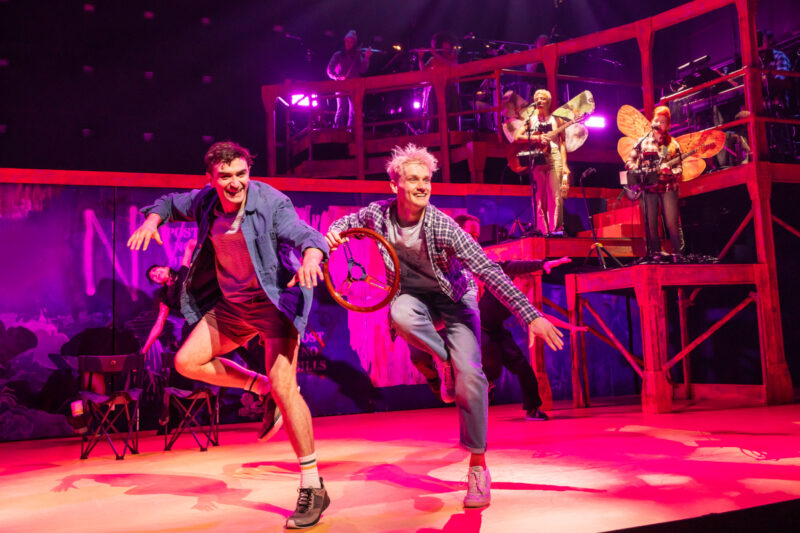
The show is structured around a circle of storytellers, with each song telling its own unique tale. Each number was an opportunity for Stirling Baker to create a fully contained world with its own lighting logic: from the graphic, Lichtenstein-inspired colors of “The Man of Metropolis” to the stark, Hitchcockian shadows of “John Wayne Gacy, Jr.” All this dynamism was accommodated by High End Systems’ SolaFrame Theatre fixtures. With a 15,000 lumen output, fixed and indexing gobo wheels, animation effects, and a wide zoom range, SolaFrame Theatre makes for a dynamic, feature-packed fixture—all with the silent operation that a theatrical environment requires.
An important facet of the show’s lighting design comes from the last place that one would expect. “As a lighting person, the first thing that you notice when you walk on stage is that the entire floor is bright yellow. My immediate thought was how on earth do you deal with a yellow floor?” says Arch. “Brandon used it as a giant bounce. He would take a light and hit that yellow floor and it would illuminate the entire cast. It blew me away.”
This result is a culmination of lots of experimentation from Stirling Baker. “I’m a huge fan of playing with the way that light reflects off the floor and the way it can light a full stage. When people see the show, it’s a cool surprise that a lot of the light that we see, even on the dancers, is very indirect. In my opinion it’s more interesting, it feels less typical.” The perfect vessel to deliver this effect was the show’s trusty Source Four LED Series 2 fixtures with the Lustr array. “Our four Series 2s are the huge workhorse for all of our reflected light,” he says. “They’re beautiful lights, and so reliable.”
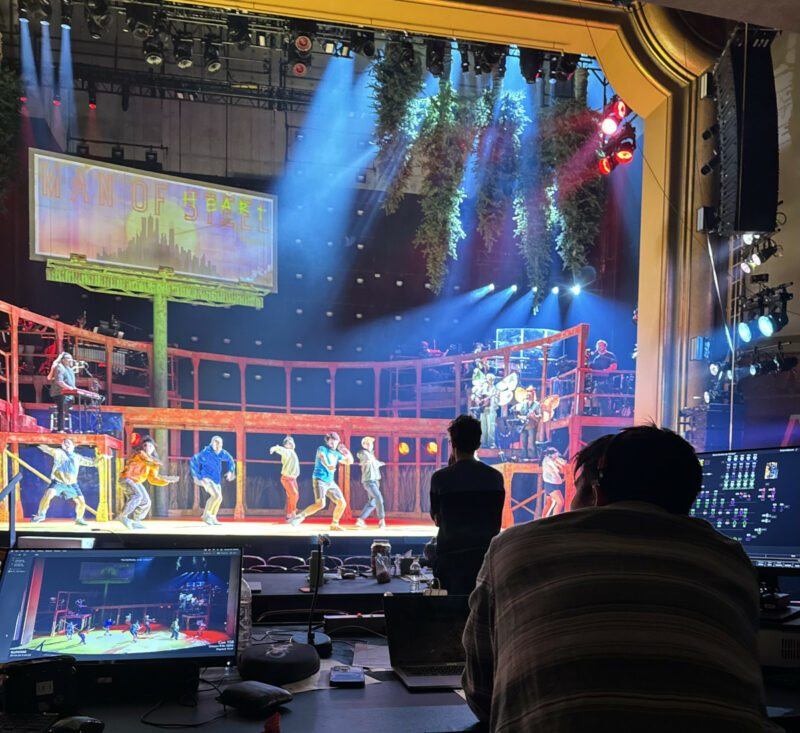
Stirling Baker closes Illinoise with a lighting cue that he considers an offering to the audience, one that inspires viewers to tell stories of their own. “I think there’s something really beautiful about a light cue, a lighting image, that can feel like an offering to its audience.” For Stirling Baker, the offering that turned him into the designer he is today came in the form of an ETC console. “I was first introduced to the world of lighting when I was 13 years old, and ETC equipment was there from the very beginning. ETC has always been a part of a designer’s introduction to light, not only for myself, but for so many people who are coming up behind me.”
Further information from ETC here!
